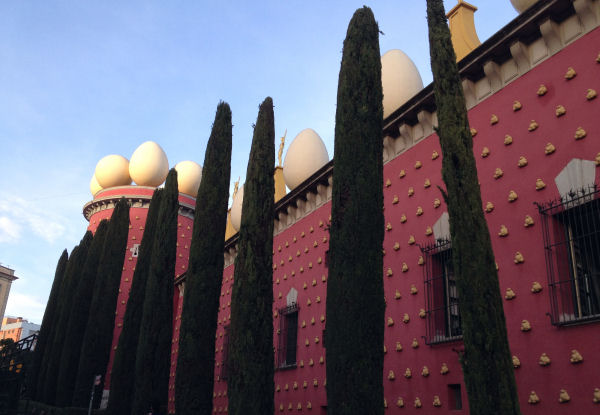Situated 20 km inland on the Ampurdan plain with the Pyrenees towering above in the near distance, Figueres is the largest town in northern Catalonia and the capital of the Alt Empordà comarca. By 2020 some 47,000 residents called Figueres home.

The town is best known for its association with surrealist artist Salvador Dalí. He was born in Figueres in 1904 and since opening in 1974 the Dalí museum has become the town’s biggest tourist draw.
Locals also remember Figueres as birthplace to Narcís Monturiol, the inventor of the world’s first successful air-independent powered submarine, as well as one of Spain’s best-known singers from the 1990s and 2000s, Mónica Naranjo.
Foreign residents of the northern Costa Brava are likely to know Figueres for its Decathlon store on the edge of town, for the hospital, which is the largest in the area, and for the ITV test centre at Vilamalla.
Travel
The town is well connected. As well as having easy access to the coast, Figueres is 30 minutes from the border with France and has excellent communications with Girona and Barcelona via road and rail.
The AP7 autopista runs from the border all the way down to southern Spain and the town has both regular and high-speed railway stations. The former is centrally located while the station for the high speed AVE is out of town at Vilafant. From there Barcelona can be reached in 50 minutes but the service extends to various destinations in Spain and France, including Madrid, Tarragona, Lyon and Paris.
Girona-Costa Brava Airport is around 40 minutes by road, while Barcelona Airport is about an hour and 40 minutes.
History
An Iberian settlement on the hill on which you now find Sant Ferran castle can be traced back to 600 BC. At the time much of the Ampurdan plain was wetlands. Later the Romans built a small town in the area of L’Aigüeta, on the north-eastern outskirts of modern Figueres.
The name Figueres first appeared in 802 as Ficerias, which is probably derived from the Latin for fig tree and the gothic Sant Pere de Figueres church is first mentioned in 1020 as Sancti Petri de Figarias. It was around the parish church that the village grew.
The castle of Sant Ferran was constructed in the late 18th century and the influx of workers saw the town expand rapidly from fewer than 2,000 inhabitants to more than 5,000. When completed the castle was one of the largest fortresses in Europe.
Over the centuries Figueres came under attack numerous times, most recently during the Spanish Civil War when it was one of the most heavily bombed towns in the area. The dungeon of Sant Ferran castle was the venue for the last meeting of the democratically elected Republican government in 1939 at the end of the Spanish Civil War.
Figueres museums
Teatre-Museu Dalí: As mentioned above, the main reason most people visit Figueres is to visit the Dalí museum. It is located in a former theatre that was gutted by fire during the civil war and refurbishment only started in the 1960s after Dalí bought it to convert into a museum of his work. It has a geodesic dome on top, the external walls are covered in representations of a local type of bread and on the roof are giant eggs. You’re unlikely to miss it.
While the Dalí museum is on most visitors’ list, there are a number of other sites you might like to visit.
Sant Ferran castle: Castell de Sant Ferran is normally open to the public. They recommend you allow about an hour to visit the castle.
Catalan Toy Museum: the toy museum (Museu del Joguet de Catalunya) is located on the Rambla de Figueres in the former Hotel París.
Museum of the Ampurdan: The Museu de l’Empordà is dedicated to the cultural heritage of the Ampurdan region from prehistoric times up to the modern era.
Technical museum of the Ampurdan: The Museu de la Tècnica de l’Empordà displays around 3,000 items from a collection of items that include typewriters, sewing machines, clocks, telephones and stoves.
Municipal theatre: the Cine teatre Jardí was built in the early 20th century and is an excellent example of the Catalan Noucentisme style. You’ll find it a short walk from the Rambla in Plaça Josep Pla.

